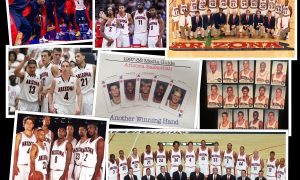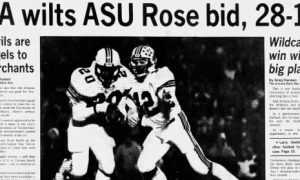FOLLOW @JAVIERJMORALES ON TWITTER!
[rps-paypal]
The front page of the El Paso Herald-Post sports section the day after Arizona almost upset eventual national champion Texas Western in 1966
[ezcol_1half id=”” class=”” style=””]

Bruce Larson took his 11-8 Arizona team to El Paso in 1966 and almost pulled off a major upset
Texas Western’s “Glory Road” toward a national title in 1966 almost veered off course against Bruce Larson’s Arizona Wildcats in an overtime game at El Paso.
The late Don Haskins made history that season by starting the first all-black lineup that won a national championship. The movie “Glory Road” in 2006 documented the achievement of Texas Western, which is now Texas-El Paso.
In a reversal of roles of Friday night’s game between No. 3 Arizona and UTEP at the Don Haskins Center, Arizona was the underdog against unbeaten Texas Western on Feb. 10, 1966. The game was played in front of an over-capacity crowd of 5,399 at the 5,200-seat Memorial Gym.
Texas Western improved to 17-0 with an 81-72 grueling win against a gritty Arizona team that entered the game with an 11-8 record.
“We did have some improvement on the boards,” the late Haskins told the El Paso Herald-Post, referencing the Miners’ 51-31 rebounding edge. “(But) Arizona had nine or 10 baskets on second shots against us.”
El Paso Herald-Post reporter Bob Ingram paraphrased Haskins as crediting Arizona for “having a team of shooters who can — and have — run up fantastic percentages in games this season”.
Arizona’s starting backcourt of Bob Spahn and Ted Pickett combined to shoot 13-of-24 from the field while 6’6″ center Bob Hansen scored 17 points on 8 of 15 shooting from the field. Pickett had a game-high 19 points and Spahn added 17. Hansen, with 10 rebounds, and Pickett, with eight, were Arizona’s only resistance against Texas Western’s impressive effort on the boards.
The Miners’ starting center David Lattin (16 points and 15 rebounds) and power forward Nevil Shed (16 points and 12 rebounds) each had a double-double and small forward Harry Flournoy had 18 rebounds with nine points.
Texas Western guard Bobby Joe Hill, who led the Miners with 20 points in the title game against Kentucky that season, struggled from the field against Larson’s team. Hill made only 5 of 20 shots from the field but converted 8 of 12 free-throw attempts to finish with 18.
“Hill really killed us,” Larson told Ingram about the trips to the foul line.
[/ezcol_1half]
[ezcol_1half_end id=”” class=”” style=””]
The boxscore of the 1966 overtime classic between Arizona and Texas Western at Memorial Gym in El Paso

[/ezcol_1half_end]

The 1965-66 national champion Texas Western Miners
[ezcol_1half id=”” class=”” style=””]
Arizona only led once (11-10 in the first half) but did not trail by more than seven until the overtime margin. In the waning seconds of regulation, after Arizona’s Harvey Fox tied the game at 67 with a minute to go, Hill missed a jump shot and Lattin failed to make the tip-in at the buzzer, according to Ingram’s report.
The Wildcats did not make a field goal in the last three minutes of overtime as Texas Western pulled away.
In their book Tucson: A Basketball Town, former Arizona standouts Bob Elliott and Eric Money quoted Larson as saying about the 1966 thriller: “We could have won that game in regulation. The game was tied and we took the last shot in regulation and it went in and out.”
That varies from Ingram’s account but Arizona put a scare into the eventual national champs, nonetheless.
Two days after the game, Tucson Citizen sports editor Carl Porter wrote a scathing column about Haskins’ program, including a line that read: “It is no secret that TWC (Texas Western College) is unlikely to win any academic All-America honors.”
Porter criticized Texas Western’s academic standards because it was not affiliated with a conference at the time. He wrote that Haskins had the ability to “sneak into school athletes who simply can’t cut it scholastically at bigger institutions.” Porter cited the season of Texas Western’s freshman team cut short because reportedly only two players remained eligible after the semester break.
A Texas Western official was quoted as saying that the freshman players did not flunk but they did not carry enough hours.
Porter went on to praise Haskins and his ability to make his offensive-minded team play sound defense.
As for the issue of race, Porter wrote about a drastic change in the El Paso area to accept an all-black lineup.
[/ezcol_1half]
[ezcol_1half_end id=”” class=”” style=””]
ARIZONA’S LONGEST SERIES
Rec: Arizona’s record against opponent. Last: Last meeting with Wildcats.
[table “” not found /]
[/ezcol_1half_end]
“No more than a dozen years ago, Negroes were unacceptable citizens as far as most El Paso fans were concerned,” Porter wrote. “Arizona and other schools had problems with housing Negro members of their teams when playing TWC. Yet Thursday night, as the Miners got their closest scare of the season in an 81-72 overtime win against Arizona, Haskins played only seven men — and all were Negroes.
“But now the El Paso fans love ’em. They poured a record-breaking (and nerve-wrecking) crowd of 5,399 into Memorial Gym as rabid supporters ringed the floor right up to the out-of-bounds lines and stacked up in the aisles and stairs. Another 600 students watched on closed-circuit TV.”
Arizona, with Elliott at center, played in a historic game at Memorial Gym in 1977. The Miners upset the 10th-ranked Wildcats 60-59 in the last game played there on Jan. 15, 1977. After that game, UTEP moved into the 12,000-seat Special Events Center, which was renamed after Haskins in 2008 after the death of the Hall of Fame coach.

The Don Haskins Center awaits Friday night’s game between No. 3 Arizona and UTEP (UTEP photo)
Haskins, nicknamed “The Bear”, retired in 1999 after 38 seasons at the school. He had a 719-353 record and won seven Western Athletic Conference titles. He took UTEP to 14 NCAA tournaments and to the NIT seven times and briefly worked as an adviser with the Chicago Bulls when former assistant Tim Floyd coached there.
Floyd, an assistant for 10 years under Haskins, is now UTEP’s head coach.
Arizona played at UTEP twice under Lute Olson, splitting each game. The Wildcats lost 51-49 in overtime in the Sun Bowl Classic title game in Olson’s first season in Tucson. The loss came a day after Arizona beat Texas Tech in overtime by the same score. In their last trip to El Paso, the Wildcats prevailed 75-61 on Dec. 18, 1994, almost 20 years ago to the day the Wildcats play against the Miners on Friday night.
Highlights of those three games:
1977 — UTEP made 15 of its 20 field-goal attempts in the second half en route to the 60-59 upset. Arizona tried to work the ball inside to Elliott but a potential game-winning shot was foiled as UTEP’s Charles Draper emerged with a steal among a mass of players near the hoop. Arizona coach Fred Snowden claimed afterward that Elliott was fouled on that play.
1983 — Pete Williams’ 16 points and nine rebounds were not enough as UTEP held on to beat Arizona in overtime to remain unbeaten at 10-0. Former Santa Rita center Dave Feitl led the Miners with seven rebounds.
1994 — Arizona won the rebounding battle, 37-28 and the Wildcats made 22 of 24 free-throw attempts in a hostile environment. Five players scored in double figures. “It was a great experience to come into this environment,” Olson told Steve Rivera of the Tucson Citizen. “It was just a good experience. And I think for the most part the fans enjoyed to see this rivalry live.”
ALLSPORTSTUCSON.com publisher, writer and editor Javier Morales is a former Arizona Press Club award winner. He also has published articles for Bleacher Report and Lindy’s College Sports.





























